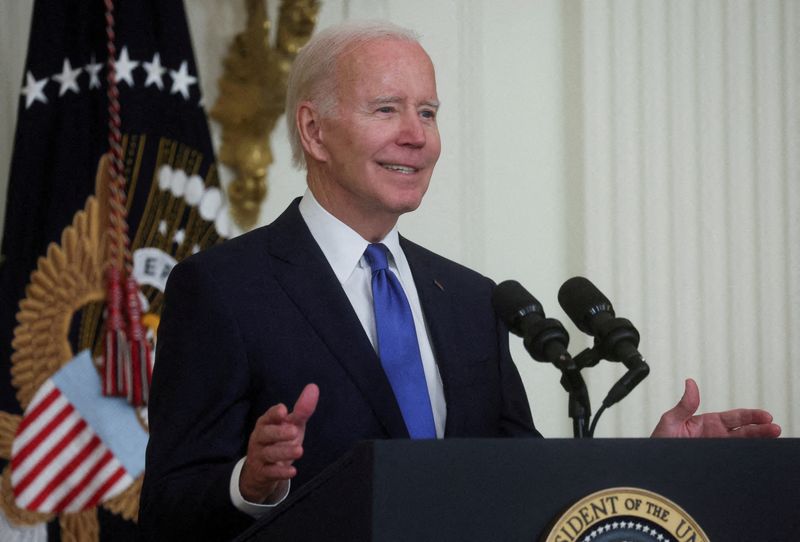One year on, Biden still needs to explain his signature clean energy legislation
2023.08.16 06:13

© Reuters. FILE PHOTO: U.S. President Joe Biden speaks about infrastructure jobs and job training in broadband, construction, and manufacturing following the passage of the Bipartisan Infrastructure Law, the CHIPS and Science Act and the Inflation Reduction Act duri
By Jarrett Renshaw
(Reuters) – U.S. President Joe Biden on Wednesday marks the first anniversary of signing his signature clean energy legislation called the Inflation Reduction Act by leading a campaign to better explain to Americans what, exactly, it does.
The climate-focused bill provides billions of dollars in tax credits to help consumers buy electric vehicles and companies produce renewable energy, as Biden aims to decarbonize the mighty U.S. power sector. It also helps seniors pay for prescription drugs, expands some elements of Obamacare and asks wealthy Americans and corporations to pick up the tab.
Twelve months after it passed, the law commonly referred to as the IRA, like most major U.S. legislation, is drawing mixed reviews. Meanwhile, many Americans, even those who support Biden, don’t know much about it, according to Reuters opinion polls.
On Wednesday, Democrat Biden will deliver remarks at the White House with U.S. lawmakers in attendance. Before the event, the administration will release a new interactive feature on invest.gov where visitors can listen to testimonials from Americans about how the legislation helped them.
Biden is seeking a second term in office in the November 2024 election in what is expected to be a rematch against former President Donald Trump, front-runner for the Republican nomination.
INVESTORS, COMPANIES LOVE IT
In a spate of investor reports before the anniversary, Wall Street analysts said the legislation has shown early signs of its economic power and predicted it will eventually lead to billions of dollars in new investments and thousands of new jobs.
While the biggest impacts will begin in 2024 and 2025, there have been more than 270 new clean energy projects announced since its passage, with investments totaling some $132 billion, according to a Bank of America (NYSE:) analyst report.
Roughly half of those investment dollars are going to electric vehicles and batteries, while the rest are going to renewable energy like solar, wind and nuclear. These investments are expected to be accompanied by over 86,000 jobs, including 50,000 jobs related to EVs.
In a report on Tuesday, Moody’s (NYSE:) said the legislation is likely supporting growth in gross domestic product, productivity and innovation.
“Over the past year, there have been signs that the legislation is contributing to a surge in clean energy manufacturing and related industries such as semiconductors, and factoring into companies’ investment decisions, including in the auto, utilities and oil and gas sectors,” Moody’s said.
DEFICIT REDUCTION MISSES MARK
Biden and Democrats promised the IRA bill would cut the U.S. budget deficit by $300 billion over 10 years by enforcing a 15% minimum corporate tax on wealthy companies, hiring more auditors to scrutinize the tax returns of rich Americans and allowing the federal government to negotiate drug prices with pharmaceutical companies.
But the tax credits have been massively popular with companies, boosting job growth, environmental benefits and the price tag. Meanwhile, Republicans used this year’s budget standoff to peel back some of Biden’s efforts to boost tax collections of wealthy Americans. And pharmaceutical companies have sued the administration over its drug negotiating plans.
That has upended financial projections, with some analysts at Goldman Sachs (NYSE:), Credit Suisse and University of Pennsylvania’s Wharton Business School predicting budget deficits in the range of $700 billion to $1.1 trillion over 10 years.
WAIT, WHAT’S THE IRA?
Biden has expressed regret at calling the bill the Inflation Reduction Act. The name helped solve a political problem for Democrats who were concerned that voters would punish them for soaring prices in the 2022 congressional elections.
“I wish I hadn’t called it that because it has less to do with reducing inflation than it has to do with providing alternatives that generate economic growth,” Biden said last week at a fundraiser in Utah.
While price increases have cooled over the past year — the inflation rate has dropped to 3.2% from 9% — most economists said little to none of the drop came from the law.
Biden and top administration officials have fanned out across the country in recent weeks to educate a cynical American public on the strengths of the economy and how his legislative agenda is changing their lives.
But Americans who voted for Biden in 2020 said they believe the economy has fared poorly under his stewardship and they might not vote for him in the November 2024 election, according to a Reuters/Ipsos poll released on Aug. 4.
About half of the respondents who voted for Biden in 2020 said they have heard little or nothing of his major policy initiatives to reduce inflation or boost spending on infrastructure.
Only 27 percent of Americans said they know a great deal or a good amount about the marquee legislation, according to a Washington Post-University of Maryland poll released on Monday.
The White House missed an opportunity by naming the legislation the Inflation Reduction Act, helping to lead to voter confusion and allowing Republicans to exploit it, Jimmy Siegel, a former corporate ad man who now helps Democrats get elected, said.
“Voters hear the Inflation Reduction Act, but they do not see their grocery bills coming down. They don’t really see gas prices coming down much. I think the provisions in the act are quite good but the problem with this Democratic administration is, people aren’t giving them credit for the things they actually have done,” he said.








